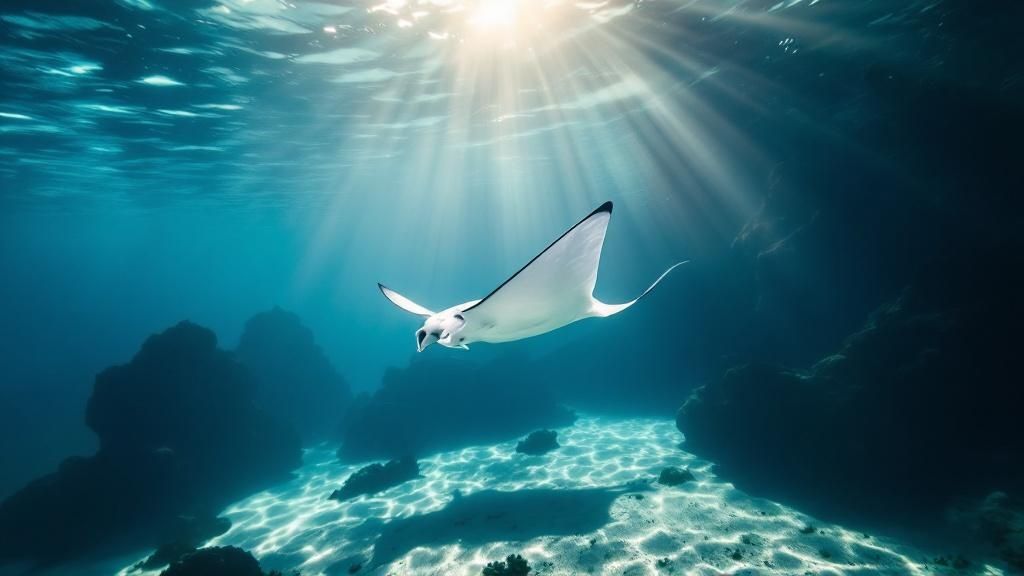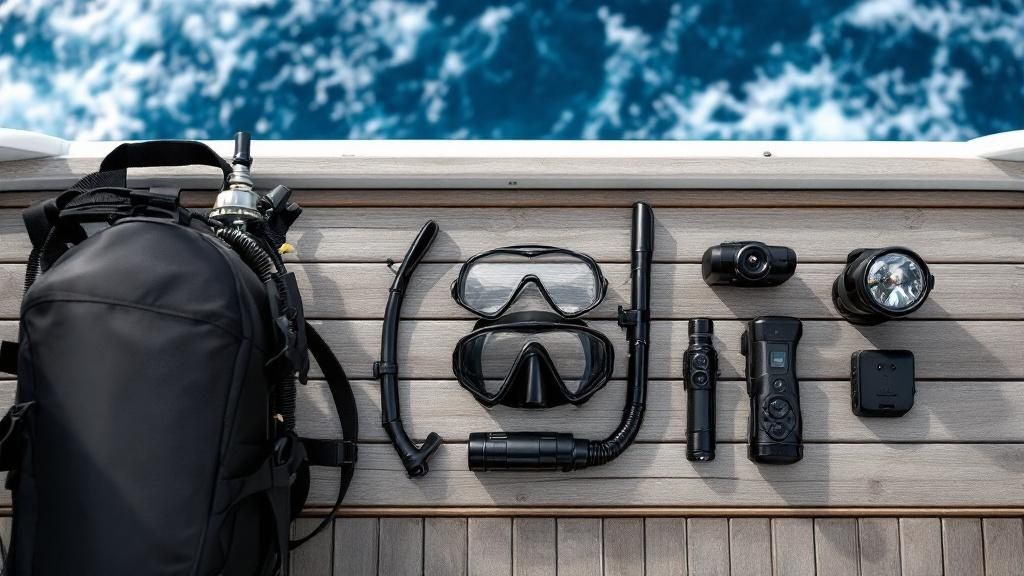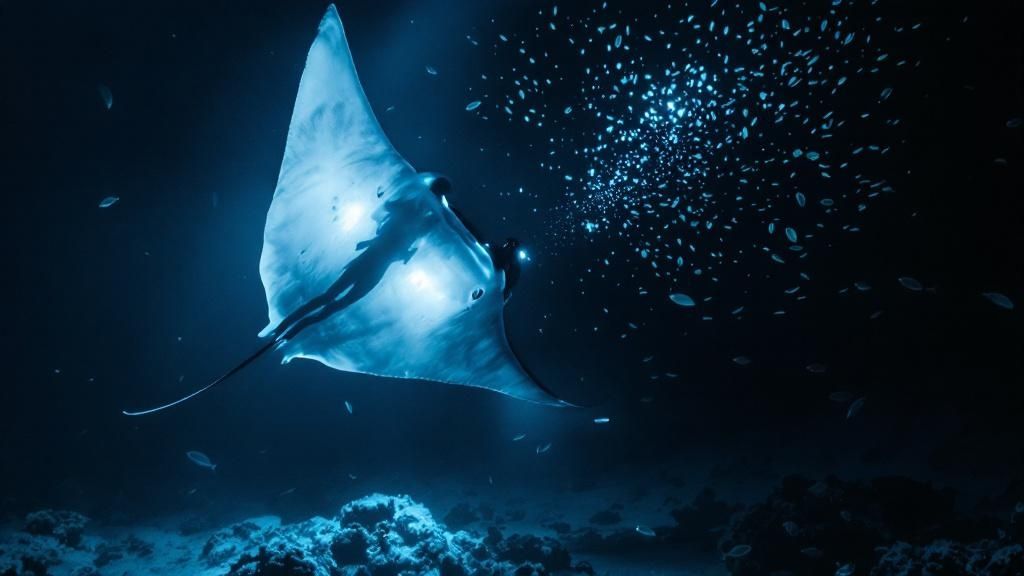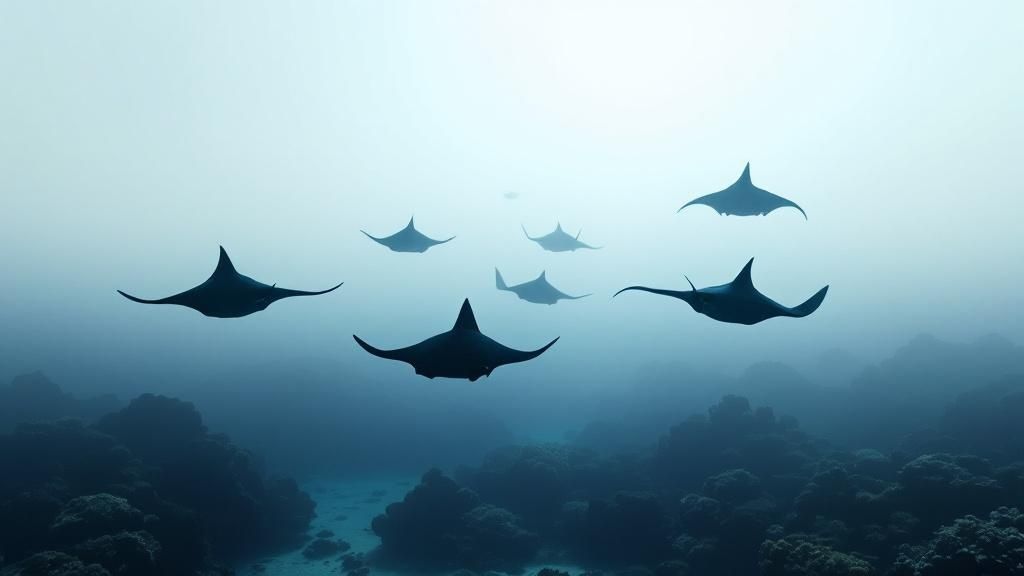Picture this: you’re floating in the warm, dark waters of the Pacific just after sunset. Suddenly, a gentle giant with a wingspan of up to 16 feet soars into view, gliding effortlessly through the water just below you. This isn’t a dream; it’s the heart of the world-famous manta ray dive in Kona, an experience that can only be described as a surreal, silent underwater ballet.
The Magic of the Kona Manta Ray Night Dive
The Kona manta ray experience is truly unlike any other wildlife encounter on the planet. This isn't just another dive or snorkel trip. It's a front-row seat to one of nature's most incredible spectacles, and it all hinges on a brilliantly simple relationship between light, plankton, and manta rays.
So, how does it all come together? Think of it as setting up a massive underwater campfire. After the sun goes down, boats head out to specific, long-established sites along the Kona coast. Once they anchor up, powerful lights are either lowered into the water or aimed down from the boat. This light has one job: to attract plankton.
A Plankton Buffet for Gentle Giants
Plankton, the tiny creatures that are the foundation of the ocean's food web, are naturally drawn to light. As they swarm to the illuminated water under the boats, they create a thick, glowing cloud—an irresistible, all-you-can-eat buffet that signals dinnertime for the stars of the show: the resident reef manta rays.
Drawn by the promise of an easy meal, the mantas arrive and get right to work. They swoop and glide with incredible grace, performing barrel rolls through the water as they filter the plankton through their massive, wide-open mouths.
There's something profoundly moving about it. Watching these enormous, gentle creatures soar just inches from you in the quiet of the night ocean is an experience that sticks with you forever. It's a powerful, humbling reminder of the sheer wonder of the natural world.
Why This Encounter Is So Reliable
Unlike so many wildlife tours that hinge on luck and migration patterns, the Kona manta ray dive boasts an insanely high success rate, often topping 90%. The secret is that these mantas are local residents. Over the years, they've learned to associate the lights with a reliable food source. They know exactly where to show up for dinner, night after night.
What started as an accidental discovery decades ago has evolved into a meticulously managed and eco-conscious adventure. This introduction just scratches the surface. For a deeper look into the whole process, you can learn more about what the manta ray night dive is and what to expect from the moment you step on board. It’s an adventure that truly has to be seen to be believed.
Why Kona Is a Manta Ray Paradise

So, what makes the manta ray dive in Kona a world-famous phenomenon? It’s not just a lucky break. It’s the result of a perfect storm of geography, biology, and a little bit of accidental history that created the planet's most reliable and jaw-dropping manta ray experience.
It all boils down to a simple, brilliant relationship. Manta rays are filter feeders, and they love to eat plankton. The Kona coast, shaped by ancient lava flows, is full of natural coves and bays that act like giant mixing bowls, concentrating these tiny organisms.
This natural buffet got a serious upgrade decades ago thanks to a bit of human intervention. A hotel on the coast decided to light up its oceanfront property at night. These bright lights attracted clouds of plankton, and it didn't take long for the local mantas to figure out that this was the spot for a nightly all-you-can-eat feast. That happy accident became the blueprint for the eco-tours we all love today.
The Science of the Underwater Ballet
Dive operators took that initial discovery and turned it into a science. Instead of relying on hotel lights, they now bring their own powerful, submerged "campfires" of light to established feeding sites. This method consistently draws in the plankton, which is basically a dinner bell for the mantas. The result is a breathtaking underwater ballet.
The stars of this nightly show are reef manta rays (Mobula alfredi), the second-largest species, which can boast wingspans of up to 18 feet. Unlike their nomadic cousins, the Kona mantas are residents. They live here year-round, which is the secret to why sightings are so incredibly consistent.
The real magic is in how they feed. As they swoop in to eat the plankton, they perform these effortless barrel rolls and graceful loops, gliding through the light beams like acrobats. It’s an intelligent, learned behavior that turns a simple meal into an unforgettable spectacle.
Why This Dive Is So Unique
Sure, you can see mantas in other parts of the world. But those encounters are often at "cleaning stations," where small fish pick parasites off the mantas' skin. While that’s cool to see, it’s nothing like the high-energy action of a feeding frenzy. The manta ray dive Kona offers you a front-row seat to this much more dramatic show.
This isn't just some tourist free-for-all, either. The whole operation is built on conservation and respect. Strict guidelines are in place to ensure the animals are never touched, chased, or stressed. With over 300 individuals identified and named by local researchers, this manta population is a protected treasure, and their well-being is always the top priority.
This commitment has turned an accidental discovery into one of the most celebrated and ethical wildlife encounters you can find anywhere. When you understand the history and biology behind it, your dive becomes more than just a tour—it’s a genuine connection to the incredible marine world of Hawaii.
Choosing Your Adventure: Snorkel or Scuba Dive
So, you're ready for the manta ray dive in Kona. The first big decision you'll make is how you want to see the show. Will you be snorkeling, watching from the surface? Or will you be on the ocean floor, fully immersed as a scuba diver? There’s no wrong answer here. Each offers a completely different vibe, and the best choice really comes down to your comfort level in the water and what kind of experience you're after.
Think of it like going to a concert. Snorkeling is your balcony seat. You get this incredible, panoramic view of the whole spectacle. You'll be holding onto a custom-built float board with bright lights pointing down, attracting the plankton. From there, you watch the mantas swoop and barrel-roll right beneath you. It’s an amazing perspective, and it’s accessible to just about anyone who can swim. This makes it a fantastic option for families, groups with different experience levels, or anyone who isn't a certified diver.
Scuba diving? That’s your front-row seat, right up against the stage. You'll settle on the sandy bottom, about 30-40 feet down, and simply look up. The experience of having these gentle giants, with wingspans that can top 12 feet, glide inches over your head is something you’ll never forget. It’s powerful, humbling, and what many divers describe as a truly spiritual encounter.
Snorkel vs. Scuba Dive: A Quick Comparison
To help you figure out which "ticket" is right for you, let's look at them side-by-side. This table breaks down the key differences between these two amazing ways to see the mantas.
| Feature | Snorkeling | Scuba Diving |
|---|---|---|
| Perspective | Bird's-eye view from the surface | Bottom-up view from the seafloor |
| Accessibility | Open to almost everyone | Requires scuba certification |
| Proximity | Very close, but from above | Potentially inches away, fully immersive |
| Physical Effort | Minimal; mostly holding onto a float | Requires managing gear and buoyancy |
| Cost | Generally more affordable | Typically a higher price point |
Honestly, both are incredible. Snorkeling is the most popular way to see the mantas for a reason—it's easy, and the view is spectacular. But if you have your scuba certification, the experience from the bottom is just on another level. You can get a deeper sense of what it's like to go on the manta ray dive in Kona, Hawaii to help picture yourself there.
Making the Right Choice for You
When it comes down to it, go with what feels right for your comfort and skill level in the ocean.
Key Takeaway: If you're not a certified diver or feel a little anxious in the water, snorkeling is the perfect choice. You will have an absolutely unforgettable time. If you are a certified diver, the scuba option delivers a perspective that is truly breathtaking.
And remember, the manta dive is just one piece of Kona’s incredible underwater world. If you're looking for another amazing day on the water, full of history and vibrant reefs, a Captain Cook Snorkel Tour in Kealakekua Bay is a must-do. No matter which adventure you pick, you're guaranteed to leave with memories that will last a lifetime.
Finding the Best Manta Ray Tour Operator

Since the manta ray dive in Kona is such a massive bucket-list experience, plenty of companies are ready and waiting to take you out on the water. But let's be clear: not all tours are created equal.
Picking the right operator is the single most important choice you'll make. It’s what separates a good dive from a truly life-changing memory, and it directly affects the well-being of the mantas. Think of it like hiring a guide for a trek up a famous mountain—you want an expert who respects the environment and keeps you safe, not just someone pointing the way.
The best operators are committed to safety, ethics, and a top-notch guest experience. They’ll have high-quality gear, passionate and knowledgeable guides, and they'll keep their groups small for a more personal adventure.
Look for Manta Ray Green List Standards
For years, the gold standard for any responsible manta tour was the Manta Ray Green List. While the official list isn't active anymore, its principles are still the benchmark for ethical operations. These guidelines were all about making sure every interaction with the mantas is passive and respectful, putting their safety above all else.
Any operator worth their salt will enforce a strict “no-touching” rule. This is absolutely critical. Manta rays have a protective mucus layer on their skin that acts as a shield against infection. When people touch them, it strips away that protective coat, leaving them vulnerable to disease. The best companies drill this into their guests before anyone even dips a toe in the water.
Key Insight: The premier tour operators see themselves as more than just a business; they are guardians of the manta rays. Their primary goal is to let you witness something magical while ensuring the local manta population stays healthy and safe for the long haul.
This commitment to conservation is essential. The manta ray night dive operations in Kona pull in over $2.5 million in revenue every year, making it a cornerstone of the local economy. In Hawaii, manta rays have been legally protected since 2009, making it illegal to harm or capture them. These protections are vital, as manta populations worldwide face serious threats from fishing.
Questions to Ask Before You Book
To find the right company, you have to be a savvy customer. Don't hesitate to call or email potential operators and ask some direct questions. How they answer will tell you everything you need to know about their operation.
- What is your guide-to-guest ratio? You’re looking for a low ratio, something like 1 guide for every 6-8 guests. That means more personal attention and better safety oversight.
- Do you follow Manta Ray Green List guidelines? Even though the list is discontinued, a firm "yes" shows they're still committed to doing things the right way.
- What is your "manta guarantee"? It’s incredibly rare for the mantas to be a no-show, but it can happen. Good companies will rebook you on another night for free if you don't see them.
- What kind of boat do you use? This comes down to personal preference. Smaller boats can offer a more intimate trip, while larger, custom-built dive boats might have more amenities like hot showers and bigger decks.
Doing a little homework upfront ensures your money supports a sustainable, high-quality tour. Not only will you have an unforgettable time, but you'll also be helping to protect the Kona mantas for generations to come. To get a better feel for what motivates people to take this trip, check out our article on why you should go on a manta ray dive in Kona.
What to Expect: A Step-by-Step Guide to Your Manta Ray Dive

Knowing the play-by-play of your manta ray dive in Kona can make all the difference. It helps replace any pre-dive jitters with pure excitement, letting you soak in every moment. Let’s walk through what your evening will look like, from checking in at the harbor to witnessing the main event.
Your adventure starts in the late afternoon, either at the dive shop or the designated harbor. You'll check in with the crew, sign the necessary waivers, and get sized up for all your gear—wetsuit, mask, fins, the works. This is a great time to ask any final questions before you hop on the boat.
Once everyone’s on board, the boat will head out to one of Kona’s legendary manta viewing sites. This isn't just a taxi ride; it’s part of the whole experience. As the sun starts its descent, lighting up the sky with those classic Hawaiian sunset colors, your guides will give a detailed briefing. They'll cover everything you need to know about the mantas and, most importantly, the rules for a safe and respectful encounter.
Getting Ready for the Water
Being prepared is the key to a comfortable and relaxed dive. Here’s a quick rundown of what to focus on before you splash in.
- What to Wear: Keep it simple. Wear your swimsuit under your clothes, and you'll pull the wetsuit on right over it before getting into the water.
- What to Bring: A towel and something warm—like a jacket or sweatshirt—are absolute musts. Even in Hawaii, that boat ride back can get chilly after a dive.
- What to Leave Behind: Try to travel light. While most boats have a dry box for storage, it’s best to leave any unnecessary valuables back at your hotel.
- Seasickness: If you even think you might get motion sickness, take your preferred remedy well before you board the boat. Trust us, being proactive is the way to go.
For a deeper dive into preparation, check out this ultimate guide to the Kona Manta Ray Night Snorkel. It’s a fantastic external resource packed with tips to make sure you’re ready for the tour.
Setting the Underwater Stage
Once you arrive at the dive site, the crew gets to work setting up the main attraction: the lights. They submerge powerful, bright lights, creating what we like to call an underwater "campfire." This light draws in the plankton, which in turn brings in the hungry manta rays.
For divers, this means descending to the sandy bottom, getting into a semi-circle with the group, and pointing your dive lights up to help build the plankton buffet. The feeling of slipping into that dark, warm ocean is incredible. You can feel the anticipation in the water as everyone waits for the first shadowy figure to glide into view.
The Golden Rule: Passive Observation Only. The single most important rule is to never touch a manta ray. Their skin is covered in a delicate, protective mucous layer that acts as their immune system. Touching them can rub it off, leaving them vulnerable to infections. Let them control the interaction; your job is to be a silent, respectful audience to their incredible underwater ballet.
Your guides are absolute pros at managing the encounter, keeping both you and the mantas safe. The in-water portion of the tour typically lasts around 45 minutes, which is plenty of time to be completely mesmerized by the show.
To see exactly how a top-tier operator orchestrates this magical experience, learn more about Kona Honu Divers' manta ray night dive in Kona, Hawaii.
Best Kona Dive Sites and Viewing Seasons

So, you want to see the manta rays. The good news is, you can have a spectacular dive any night of the year here in Kona. Our manta population doesn't migrate; they're residents, hanging out with us year-round.
That said, knowing where to go and when to go can turn a great trip into a truly unforgettable one. The real magic happens at two world-renowned sites. These aren't just random spots on a map—they are established feeding grounds where, for decades, mantas have learned to show up for their nightly plankton buffet.
Manta Village vs. Manta Heaven
Your tour will almost certainly take you to one of two legendary locations, and each has its own distinct personality.
-
Manta Village (Keauhou Bay): This is the O.G. manta ray night dive site, located just south of Kailua-Kona. It's famous for its relatively shallow, calm waters and a sandy bottom. This makes it incredibly comfortable for both first-time divers and snorkelers. The bay is naturally protected, which usually means less current and a very, very high success rate for seeing the mantas.
-
Manta Heaven (Garden Eel Cove): You'll find this spot north of town, closer to the airport. It's a bit deeper and can sometimes have a bit more current to deal with. Because of this, it tends to be a favorite among more experienced divers and photographers who are comfortable in a more dynamic environment. The potential payoff is huge—this site sometimes draws in massive groups of mantas for a truly jaw-dropping spectacle.
Every year, around 80,000 people come to Kona specifically for these tours. It’s a powerful testament to just how special this experience is. Manta Village is beloved for its reliability and what feels like a beautifully choreographed "manta ballet," while Manta Heaven’s deeper setting can offer thrillingly close passes that are a dream for seasoned divers.
The Best Time of Year to Go
While you can see mantas every single month, the absolute sweet spot for a manta ray dive in Kona is generally between April and October.
During these months, the ocean is typically at its calmest. The water warms up to a pleasant 75–80°F, which is comfortable for everyone.
Pro Tip: Warmer water often means bigger plankton blooms. This is basically a giant dinner bell for the mantas, and it can attract even larger groups to the dive sites. More food means more mantas, which means more incredible underwater acrobatics for you to witness.
What about the winter? From November to March, we can get bigger ocean swells and cooler water, which might occasionally cause a tour to be canceled for safety. But a successful winter dive is every bit as magical. No matter when you book, your odds of having a mind-blowing encounter are incredibly high.
Ultimately, picking the perfect time is about balancing the weather with your own travel plans. To really nail down the best timing for your trip, it’s worth learning more about the best time of year to see manta rays in Kona. A little planning goes a long way toward ensuring you have the adventure of a lifetime.
Answering Your Kona Manta Ray Dive Questions
As you get closer to booking what might be the adventure of a lifetime, it’s only natural for a few last-minute questions to pop up. Getting those questions answered is the difference between hesitation and diving right in. Let's walk through some of the most common things people ask about the manta ray dive in Kona.
The big one is always safety. Is it really safe to get in the water at night with these massive creatures? The answer is a resounding yes. There's a good reason we call them gentle giants—manta rays have no teeth, no stingers, and no barbs. They are peaceful filter feeders, and frankly, they couldn't be less interested in bothering people.
On top of that, every single tour is guided by seasoned professionals who live and breathe ocean safety. They manage the entire experience, creating a controlled, secure environment where all you have to do is enjoy the show.
Addressing Common Concerns
We get it. Not everyone is an Olympic swimmer. A lot of folks worry about their swimming skills, and that's perfectly okay.
Reputable operators have you covered. You'll be required to wear flotation devices, like a wetsuit and a snorkel vest, which make you incredibly buoyant. Many tours also have big, custom-built rafts that float on the surface, equipped with powerful lights. You can just hang on comfortably and watch the whole thing unfold.
Another common worry is about the stars of the show themselves. What if the mantas don't show up? While it’s exceedingly rare for a "no-show" night—these feeding sites are remarkably consistent—it can happen. This is where choosing a top-tier company really pays off. Most of the best operators have a "manta guarantee." If you don't see a single manta, they'll book you on another tour for free.
This isn't just luck, by the way. This high success rate is backed by solid research. Between 2009 and 2014, scientists meticulously tracked individual manta sightings along the Kona Coast, at sites just like Manta Village and Manta Heaven. This data confirms just how reliable these gentle giants are. You can discover more about these manta ray findings and see the science that supports this incredible, sustainable experience.
Is The Night Dive Scary?
What about the dark? Being in the open ocean at night sounds intimidating, right? For most people, the answer is a surprising "no." The boats use incredibly powerful lights that create a brilliantly illuminated underwater stage.
The experience feels less like floating in a dark, vast ocean and more like having a front-row seat at a beautifully lit aquatic theater. Any nervousness you might have melts away the second you see these graceful giants gliding through the beams of light. It's pure awe.
With these common questions out of the way, you can book your tour with total confidence, ready to be part of one of the most magical wildlife encounters on Earth.
Ready to witness the underwater ballet for yourself? Kona Honu Divers offers safe, ethical, and unforgettable manta ray tours led by experienced professionals. Book your adventure today!
